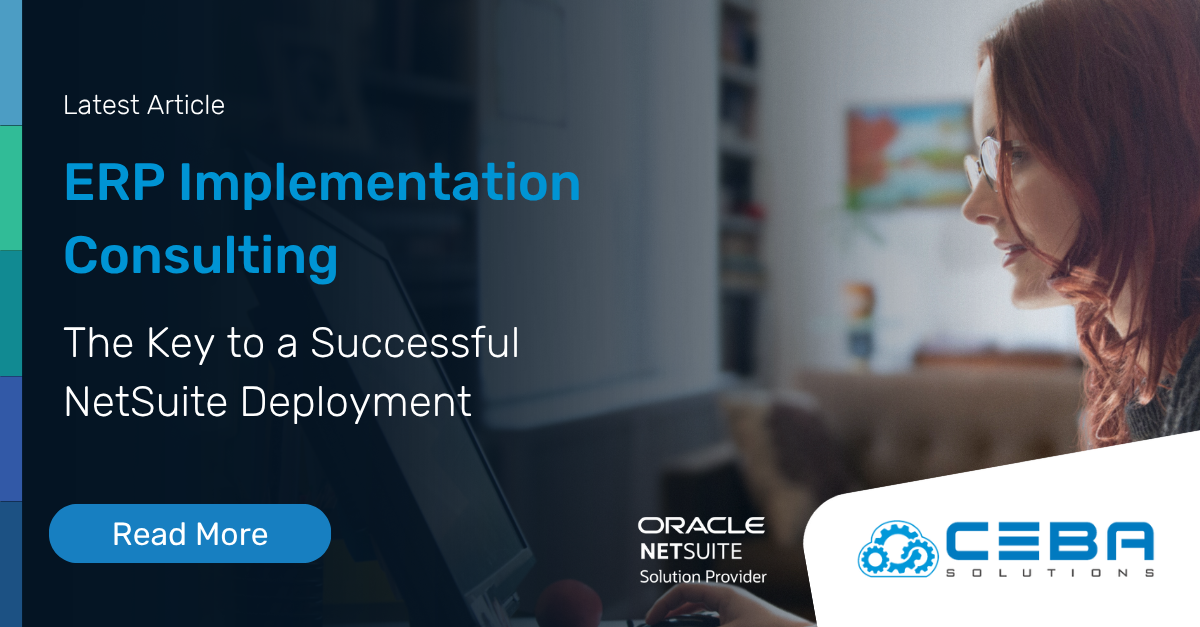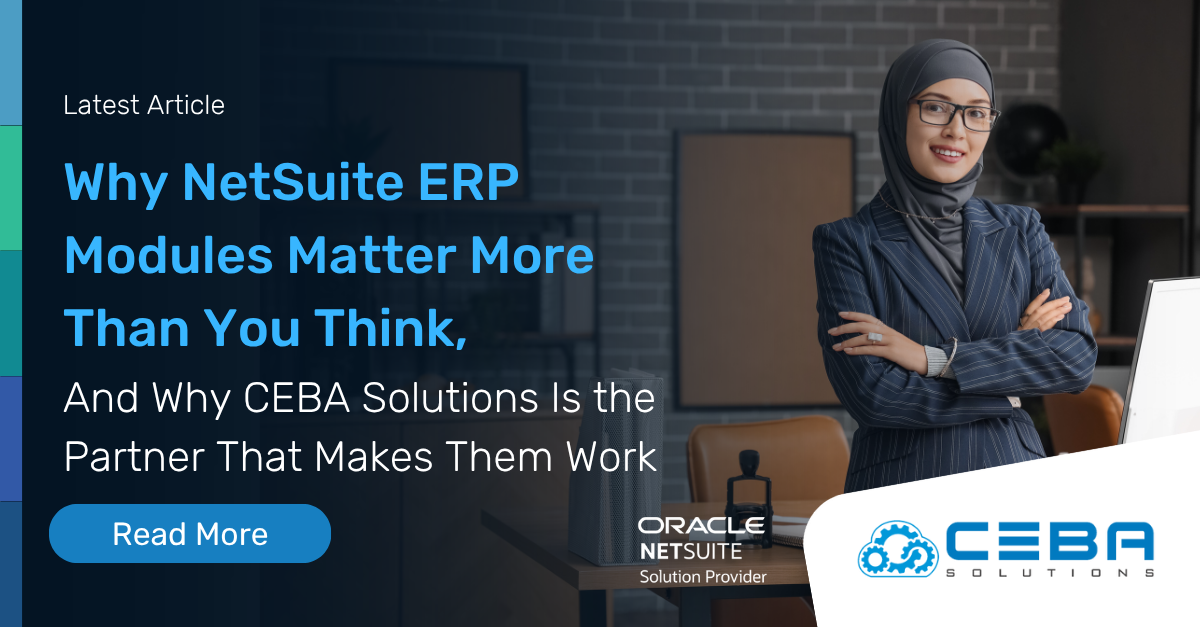
Uncover the Essential ERP Components You Should be Looking for to Facilitate Rapid Business Growth
Uncover the Essential ERP Components You Should be Looking for to Facilitate Rapid Business Growth
An Enterprise Resource Planning software (ERP) is the backbone of modern businesses, seamlessly integrating critical processes for all business departments across various industries. In this article we will explore the key ERP components that make up an ERP system and expand on the top 10 features of each, and how they support business growth.
The Customer Relationship Management Component (CRM): Nurturing Customer Connections
Customer Relationship Management (CRM) is a vital component of an ERP system, focusing on building and enhancing customer relationships. By centralizing customer information, businesses gain a comprehensive understanding of their customers' needs and preferences.
With CRM modules, such as NetSuite, integrated into ERP systems, companies can streamline sales and marketing processes, track customer interactions, and provide exceptional customer service. This component enables businesses to nurture customer relationships, create personalized experiences, and drive satisfaction and loyalty. By leveraging CRM capabilities, organizations improve customer retention, boost sales, and achieve their growth objectives.
Top 10 Features of NetSuite’s CRM Module
Customer Relationship Management (CRM) empowering businesses to build strong and lasting relationships with their customers. Let's explore the top 10 features of CRM that help organizations nurture customer connections and drive business success.
Centralized Customer Database
CRM modules within an ERP system provide a single customer database where businesses can store and access customer information. This feature allows for a holistic view of customer interactions, preferences, purchase history, and other relevant details. Having a single source of truth enhances data accuracy and ensures a comprehensive understanding of each customer.
Sales and Marketing Automation
CRM functionalities automate sales and marketing processes, enabling businesses to streamline their operations. From lead generation to nurturing and conversion, CRM systems automate tasks such as lead tracking, opportunity management, email campaigns, and sales forecasting. These features help sales and marketing teams work more efficiently, resulting in improved productivity and increased revenue.
Customer Interaction Tracking
Tracking customer interactions across various touchpoints is crucial for understanding customer behavior and preferences. CRM systems enable businesses to capture and analyze interactions through different channels, such as email, phone calls, website visits, and social media. This feature provides valuable insights into customer engagement and helps tailor interactions based on individual preferences.
Customer Service and Support
CRM modules in an ERP system enhance customer service and support capabilities. By centralizing customer information, businesses can quickly access relevant details and provide personalized assistance. CRM features such as case management, ticketing systems, and knowledge bases enable efficient issue resolution, timely responses, and effective customer support.
Lead and Opportunity Management
CRM systems facilitate lead and opportunity management by providing a structured framework to track and prioritize leads. With CRM features like lead scoring, qualification, and assignment, businesses can allocate resources effectively, focus on high-potential leads, and maximize conversion rates. This feature streamlines the sales process, enhances lead nurturing, and drives revenue growth.
Sales Forecasting and Pipeline Management
Accurate sales forecasting and pipeline management are essential for effective resource planning and decision-making. CRM functionalities allow businesses to analyze sales data, track opportunities, and generate real-time reports and forecasts. This feature enables organizations to make informed sales projections, allocate resources appropriately, and identify areas for improvement.
Customer Segmentation and Targeting
CRM systems offer customer segmentation capabilities, allowing businesses to categorize customers based on specific criteria. By segmenting customers, organizations can tailor marketing campaigns, product offerings, and communication strategies to specific customer groups. This feature improves targeting precision, enhances personalization, and increases customer engagement.
Sales Performance Analytics
CRM modules provide sales performance analytics, enabling organizations to measure and analyze individual and team sales performance. By monitoring key metrics such as revenue, conversion rates, and sales activities, businesses can identify top-performing individuals, areas of improvement, and sales trends. This feature facilitates data-driven decision-making, performance evaluation, and sales coaching.
"NetSuite's CRM automates sales, tracks interactions, enhances service, and manages leads. It provides sales forecasts, customer segmentation, performance analytics, and integrates with marketing automation. Its mobile accessibility ensures real-time updates and increased productivity." - Zabe Siddique
Integration with Marketing Automation
An integration between CRM and marketing automation platforms allows for seamless data flow and collaboration between sales and marketing teams. This integration enables the alignment of marketing campaigns with sales activities, improves lead nurturing and qualification, and provides a cohesive customer experience. By leveraging this feature, organizations can enhance lead-to-revenue processes and maximize marketing ROI.
Mobile CRM Accessibility
Mobile accessibility is a crucial feature of CRM in today's business landscape. Mobile CRM applications allow sales and service teams to access customer information, track activities, and respond to inquiries on the go. This feature empowers field representatives, improves responsiveness, and enables real-time updates, enhancing customer satisfaction and driving productivity.
The Supply Chain Management Component (SCM): Orchestrating Seamless Operations
Supply Chain Management (SCM) encompasses the processes involved in sourcing, producing, and delivering goods and services. Effective SCM allows organizations to optimize their operations, reduce costs, and enhance customer satisfaction.
With the right SCM strategies and tools integrated into an ERP system like NetSuite, businesses gain real-time visibility into their supply chain. They can make data-driven decisions, respond promptly to changes in demand or supply, and ensure timely deliveries. Collaboration and communication with suppliers, manufacturers, distributors, and retailers are seamlessly facilitated, improving coordination, inventory management, and reducing lead times.
Top 10 Features of NetSuite’s SCM Module
Supply Chain Management (SCM) is a critical component of an ERP system, enabling businesses to orchestrate seamless operations throughout their supply chain. Let's explore the top 10 features of SCM that help organizations optimize their processes, reduce costs, and enhance customer satisfaction.
Demand Planning
Effective demand forecasting and planning are crucial for organizations to meet customer needs and optimize resource allocation. SCM modules within an ERP system provide tools and analytics to analyze historical data, identify demand patterns, and forecast future demand. This feature enables businesses to optimize inventory levels, production capacity, and logistics planning.
Inventory Management
Inventory management is a core aspect of SCM, ensuring the right products are available at the right time. ERP systems with SCM functionalities allow businesses to track inventory levels, automate replenishment processes, and optimize inventory across multiple locations. This feature minimizes stockouts, reduces excess inventory, and improves cash flow.
Supplier Relationship Management
Managing supplier relationships is critical for a smooth supply chain. SCM modules provide features to manage supplier information, track performance, and maintain effective communication. With this feature, businesses can collaborate closely with suppliers, streamline procurement processes, and ensure timely deliveries of quality materials or products.
Procurement and Purchase Order Management
Efficient procurement processes are essential for cost savings and timely acquisition of goods and services. SCM functionalities within an ERP system automate procurement workflows, streamline purchase order management, and enable electronic collaboration with suppliers. This feature ensures accurate ordering, improves supplier relationships, and reduces manual errors.

Uncover the Essential ERP Components You Should be Looking for to Facilitate Rapid Business Growth
Download Here!
Warehouse Management
Warehouse management features in SCM modules optimize storage, handling, and movement of goods within warehouses. Businesses can leverage functionalities such as inventory tracking, picking, packing, and shipping optimization to streamline warehouse operations. This feature enhances inventory accuracy, reduces order fulfillment time, and improves overall efficiency.
Logistics and Transportation Management
Efficient logistics and transportation management are crucial for timely and cost-effective product delivery. SCM modules in an ERP system enable businesses to optimize transportation routes, track shipments, and manage carrier relationships. This feature ensures on-time deliveries, reduces transportation costs, and enhances customer satisfaction.
Supply Chain Visibility and Analytics
Real-time visibility into the supply chain is a powerful feature of SCM in an ERP system. By capturing and analyzing data from various sources such as production, inventory, and sales, businesses gain valuable insights into their operations. This feature facilitates data-driven decision-making, identifies trends, improves forecasting accuracy, and enhances overall supply chain performance.
Quality Management
Maintaining product quality is crucial for customer satisfaction and brand reputation. SCM modules offer quality management features that enable businesses to track and manage quality across the supply chain. From supplier quality control to product inspections, this feature ensures consistent quality standards and reduces the risk of product recalls or customer complaints.
Compliance and Risk Management
Compliance with regulations and risk mitigation are key considerations in supply chain operations. SCM functionalities in an ERP system help businesses manage compliance requirements, monitor regulatory changes, and implement risk mitigation strategies. This feature ensures adherence to legal and industry standards, minimizes supply chain disruptions, and protects the organization's reputation.
Collaboration and Communication
Collaboration and communication are essential for seamless supply chain operations. SCM modules facilitate collaboration among supply chain stakeholders, including suppliers, manufacturers, distributors, and retailers. Integrated communication tools, shared data repositories, and real-time updates foster effective collaboration, improve coordination, and enhance overall supply chain efficiency.
The Accounting and Finance Component: Empowering Financial Excellence
The accounting and financial management component of an ERP system automates financial processes and provides insights for effective planning and budgeting. This module offers a comprehensive suite of features that ensure accurate and efficient financial operations.
Budget tracking within the finance management module enables organizations to set and monitor budgets across departments or projects. Real-time updates and comparisons with budgeted amounts help identify discrepancies and take corrective actions. Profit/loss analysis provides insights into the profitability of different products or business units, aiding decision-making.
Additionally, the accounts payable and receivable functionality streamlines payment management, handling invoices, payments, and collections efficiently. By simplifying financial processes, an ERP system empowers businesses to make informed decisions, track financial performance, and comply with regulations.
Top 10 Features of NetSuite’s Accounting and Finance Module
The accounting and finance component of an ERP system is essential for empowering financial excellence within organizations. Let's explore the top 10 features of this module that streamline financial processes, provide valuable insights, and ensure compliance.
General Ledger Management
The general ledger serves as the backbone of financial management. ERP systems offer robust general ledger functionalities, allowing organizations to record, classify, and summarize financial transactions accurately. This feature provides a comprehensive view of financial data and supports financial reporting.
Accounts Payable and Receivable
Efficient management of accounts payable and receivable is critical for healthy cash flow. ERP systems streamline the processes involved in handling invoices, payments, and collections. This feature ensures timely payments, tracks outstanding balances, and improves cash flow management.
Financial Reporting
Accurate and timely financial reporting is essential for decision-making and compliance. ERP systems provide comprehensive reporting tools that generate financial statements, balance sheets, income statements, and cash flow statements. This feature enables organizations to gain insights into their financial performance and meet reporting requirements.
Budgeting and Forecasting
Budgeting and forecasting functionalities within an ERP system enable organizations to plan and allocate financial resources effectively. This feature allows businesses to set budgets, track actual expenses, and compare them to the budgeted amounts. It aids in identifying variances and making informed decisions to ensure financial stability.
Fixed Asset Management
Effective management of fixed assets is crucial for accurate financial reporting and compliance. ERP systems provide features to track and manage fixed assets throughout their lifecycle, from acquisition to disposal. This feature automates depreciation calculations, monitors asset values, and ensures compliance with accounting standards.
Cost Management
Cost management functionalities within an ERP system help organizations monitor and control costs. This feature allows businesses to track expenses, analyze cost drivers, and identify areas for cost reduction. By gaining insights into cost structures, organizations can optimize resource allocation and improve profitability.
Cash Management
Cash management is vital for maintaining liquidity and meeting financial obligations. ERP systems offer cash management features that help organizations forecast cash flows, manage bank accounts, and optimize cash positions. This feature improves cash visibility, reduces the risk of cash shortages, and enhances financial stability.
Tax Management
Tax management functionalities within an ERP system automate tax-related processes and ensure compliance with tax regulations. This feature simplifies tax calculations, generates accurate tax reports, and facilitates seamless tax filing. It helps businesses meet their tax obligations and mitigate the risk of non-compliance.
Audit and Compliance
Compliance with financial regulations and internal controls is critical for organizations. ERP systems provide audit and compliance features that enable businesses to maintain accurate financial records, enforce segregation of duties, and track changes to financial data. This feature supports internal and external audits, ensuring adherence to regulatory requirements.
Integration with Other Modules
The integration of the accounting and finance module with other ERP modules ensures seamless data flow and eliminates manual data entry. This feature enables real-time updates across the ERP system, reduces errors, and improves overall operational efficiency.
The Human Resource Management Component (HRM): Optimizing Workforce Potential
Human Resource Management (HRM) software focuses on employee management and automating critical tasks related to payroll, benefits administration, and timekeeping.
By centralizing employee information, HRM streamlines employee management and ensures data accuracy. Automated payroll processing reduces errors, saves time, and ensures timely payments. Benefits administration simplifies tracking, enrollment, and reporting. Timekeeping functionality facilitates attendance tracking, leave management, and optimized workforce planning.
By leveraging the HRM component of an ERP system, businesses can improve productivity, reduce costs, and effectively manage their workforce. This enables them to allocate resources efficiently and focus on strategic planning and value-added activities.
"HRM software centralizes employee data, streamlines management, and automates payroll, benefits, and timekeeping. It enhances productivity, reduces costs, optimizes workforce planning, and allows businesses to focus on strategic planning." - Zabe Siddique
Top 10 Features of NetSuite Human Resource Management (HRM) Module
The Human Resource Management (HRM) component of an ERP system plays a crucial role in optimizing workforce potential and automating essential HR tasks. Let's explore the top 10 features of this module that enhance employee management and streamline HR processes.
Employee Information Centralization
The HRM module centralizes employee information, ensuring easy access and accurate data. It serves as a centralized database for employee profiles, contact details, performance records, and training history. This feature enables HR teams to efficiently manage and retrieve employee information.
Payroll Management
Payroll management functionality automates the complex process of calculating employee salaries, taxes, and benefits deductions. This feature ensures accurate and timely payroll processing, reducing manual errors, saving time, and improving overall payroll efficiency.
Benefits Administration
Benefits administration within the HRM module simplifies the management of employee benefits. This feature enables HR teams to track employee benefits, manage enrollments, generate benefit-related reports, and ensure compliance with benefit regulations. It streamlines benefits administration processes, saving time and reducing administrative burden.
Time and Attendance Tracking
Time and attendance tracking functionality facilitates accurate monitoring of employee attendance, leave management, and schedule adherence. This feature automates timekeeping processes, enables employees to log their time, and allows HR teams to generate comprehensive reports for attendance and leave management.
Performance Management
Performance management features within the HRM module streamline the performance evaluation process. This feature enables HR teams and managers to set performance goals, conduct performance reviews, and track employee progress. It fosters continuous feedback, improves performance transparency, and supports employee development.
Training and Development
Training and development functionalities within the HRM module help organizations manage employee training programs effectively. This feature allows HR teams to track employee training needs, schedule training sessions, and manage training records. It enhances employee skills and competencies, promoting professional growth and organizational development.
Recruitment and Onboarding
Recruitment and onboarding features streamline the hiring process, from job posting to candidate selection and onboarding. This feature enables HR teams to manage job vacancies, track applicants, conduct interviews, and streamline the onboarding process for new hires. It ensures a seamless transition for new employees, reducing administrative tasks and improving the overall recruitment experience.
Employee Self-Service
Employee self-service functionalities empower employees to manage their personal information, access pay stubs, update contact details, request time off, and view training opportunities. This feature reduces administrative tasks for HR teams and promotes employee autonomy and engagement.
Compliance Management
Compliance management functionalities within the HRM module ensure adherence to labor laws, regulations, and internal policies. This feature helps HR teams stay up-to-date with compliance requirements, manage documentation, and track compliance-related activities. It minimizes legal risks and promotes a culture of compliance within the organization.
Reporting and Analytics
Reporting and analytics features provide HR teams and managers with insights into workforce trends, performance metrics, and HR-related analytics. This feature enables data-driven decision-making, identifies areas for improvement, and supports strategic workforce planning. It helps HR teams align HR strategies with organizational goals and optimize workforce potential.
The Manufacturing and Logistics Component (MRP): Streamlining Production and Delivery
Manufacturing and logistics are essential components within an ERP system that optimize production processes and manage the movement of goods. By integrating these functionalities, businesses can achieve improved efficiency and cost savings across their supply chain.
Automation of production planning and scheduling within an ERP system allows for better resource management, order allocation, and real-time progress tracking. Enhanced visibility into manufacturing processes enables identification of bottlenecks, optimization of labor and equipment utilization, and overall improved production efficiency.
Logistics optimization facilitates accurate inventory management, ensuring the availability of products at the right time. Real-time monitoring of inventory levels minimizes the risk of stockouts or excess inventory. By capturing and analyzing data from various sources, ERP systems provide valuable insights into operations, aiding decision-making, trend identification, demand forecasting, and resource optimization.
Top 10 Features of NetSuite’s Manufacturing and Logistics Module
The Manufacturing and Logistics components of an ERP system play a vital role in streamlining production processes and managing the movement of goods. Let's explore the top 10 features of this module that enhance manufacturing efficiency and optimize logistics operations.
1. Production Planning and Scheduling
Production planning and scheduling functionality within the ERP system automates the process of allocating resources, managing production orders, and tracking progress. This feature enables organizations to optimize resource utilization, allocate orders efficiently, and monitor real-time production progress.
2. Inventory Management
Inventory management features facilitate accurate tracking and management of inventory levels. The ERP system provides real-time visibility into inventory, ensuring optimal stock levels, minimizing stockouts, and reducing excess inventory. This feature aids in demand forecasting, optimizing supply chain processes, and reducing carrying costs.
3. Quality Control
Quality control functionalities within the ERP system enable organizations to maintain and improve product quality. This feature encompasses quality checks, inspections, and testing throughout the production process. It ensures adherence to quality standards, reduces defects, and enhances customer satisfaction.
4. Material Requirement Planning (MRP)
Material Requirement Planning (MRP) features automate the process of determining material requirements for production. This feature considers production schedules, inventory levels, and demand forecasts to generate accurate material requisitions. It helps optimize procurement, minimize stockouts, and reduce carrying costs.
5. Shop Floor Control
Shop floor control functionalities enable real-time monitoring and control of manufacturing operations. This feature tracks work orders, provides visibility into production status, and captures data on production activities. It ensures efficient coordination, reduces bottlenecks, and enables prompt action for improved production efficiency.
6. Equipment Maintenance
Equipment maintenance features within the ERP system facilitate proactive maintenance scheduling and tracking. This feature helps organizations optimize equipment utilization, reduce downtime, and extend the lifespan of machinery. It ensures smooth production operations and minimizes disruptions.
7. Supply Chain Collaboration
Supply chain collaboration functionalities promote seamless collaboration and communication with suppliers, manufacturers, distributors, and retailers. This feature facilitates data sharing, order coordination, and real-time information exchange across the supply chain. It enhances collaboration, reduces lead times, and optimizes supply chain performance.
8. Warehouse Management
Warehouse management features streamline the receipt, storage, and movement of goods within the warehouse. This feature enables efficient inventory management, accurate order fulfillment, and optimized warehouse layout. It improves warehouse operations, minimizes errors, and enhances order accuracy.
9. Transportation Management
Transportation management functionalities within the ERP system optimize the planning, execution, and tracking of transportation activities. This feature enables organizations to manage transportation routes, carrier selection, and shipment tracking. It reduces transportation costs, improves delivery accuracy, and enhances customer satisfaction.
10. Reporting, Analytics and Business Intelligence
Reporting and analytics features provide insights into manufacturing and logistics performance. This feature enables organizations to generate comprehensive reports, analyze key performance indicators (KPIs), and identify areas for improvement. It aids in data-driven decision-making, resource optimization, and continuous process improvement.
ERP Provides a United Platform To Manage Business Processes from A Single Source of Truth
An ERP system is a powerful tool that integrates key components like CRM, SCM, accounting and finance, HRM, and manufacturing and logistics. By implementing an ERP system, businesses can enhance customer relationships, optimize supply chain operations, streamline financial processes, effectively manage employees, and improve production and delivery efficiency.
The seamless integration of these components enables organizations to make informed decisions, drive growth, and gain a competitive edge in today's dynamic marketplace. The comprehensive insights, automation, and collaboration facilitated by an ERP system empower businesses to navigate challenges, meet customer expectations, and achieve their goals.









